Everyone is wondering when JaVale McGee will make it back to the court. Nuggets head coach Brian Shaw doesn’t know if he’ll have his big shot blocker back in the lineup for opening night or not. Fans are anxious to see McGee play, reporters and this blogger, too. McGee’s last game was on Nov. 8th, 2013 in Phoenix against the Suns.
We are now 11 whole months away from the last time we saw JaVale on the court in a Nuggets uniform. He has been involved in practice, but is still experiencing soreness in his left tibia, where he had surgery. This is what Brian Shaw told us before the team’s game against the Oklahoma City Thunder on Oct. 8th:
"What he's going through right now is when he has practiced and he has done physical work out there on the floor, he's the only one that's shown some soreness the next day," Shaw said. "But from our medical staff they say that's pretty natural. He's going to be sore and then he'll take a day [to rest] and the soreness will go away and then he'll do a little bit more the next time."
We learned from the Denver Post's Chris Dempsey a little more about McGee's surgery:
McGee, 26, arrived at camp the strongest he's ever been – 270 pounds of muscle. He also arrived with a titanium rod in his left shin after surgery to correct a stress fracture in his tibia.
What do we know about titanium rods? A quick Google search turned up that Paul George will have a titanium rod to recover from his gruesome injury, same with Kevin Ware (another horrific injury from his days at Louisville), and Joe Alexander also plays with a titanium rod in his leg after surgery to correct a stress fracture in his left tibia.
Alexander was briefly in Nuggets training camp this season, but left the team after just a few days. Andrew Matheson, of the Santa Cruz Sentinel, penned a fantastic piece on Alexander back in March of 2014 (highly encourage you to read the entire thing, it's very good). Let's dissect a bit of that article and see what type of road McGee's recovery is on, Alexander missed 24 months with his injury:
Alexander discovered a stress fracture to his left tibia in late 2011. Since then, he has experienced a long road – seemingly endless, at times – to recovery. He had surgery some 14 months ago and has been strengthening and conditioning his left leg ever since. Setbacks have been frequent – sometimes every other day, even – and the restoration process is expected to continue through the foreseeable future.
"It was pretty devastating to me on two fronts," Alexander said. "One, that I would have to take a lot of time off, but, two, I didn't know how much (time) and no one else seemed to know, either. With this injury, it's kind of a wild card as far as when you'll be able to come back from it.
"So, it was like crawling in the dark. You never know how long it will take to heal. It's different for each guy. One guy could take three weeks, one guy could take 12 months. Nobody can tell you when it will be good."
Alexander opted to take what he called the "passive route" and bypass surgery, instead allowing his body to heal on its own.
Obviously that approach didn't pan out. After a year had passed and the fracture still hadn't properly healed, Alexander finally underwent the surgery that left him with three scars on his left leg – two for where the nails were put in, one for where doctors made an incision so they could slide a titanium rod down his bone.
Like McGee, Alexander put off surgery for as long as possible. JaVale said at Media Day that he didn't want to have the surgery until he exhausted other options – he didn't want to miss a lot of time. Unlike Alexander, McGee didn't wait a year to get the surgery, he had surgery on Feb. 20th, 2014 – roughly three months after his last game with the team in Phoenix.
Now for a bit of the scary tale from Alexander:
The surgery was supposed to help fix everything, but the setbacks continued. Frustrated, he began researching other professional athletes who had stress-fracture surgery and came back to enjoy successful basketball careers.
The list was fairly short, he said.
"I found like, one guy. And I found NBA guys who had the surgery, but I never found anybody who had it, came back and had a successful career," Alexander said. "So that's when I got worried, you know?
"Maybe that's because people don't come back from this."
Alexander had to give it a try.
Alexander is right, there isn't a long successful list of guys coming back from stress fracture surgery – not like the success stories of ACL injuries. This is a different beast, and Alexander had to learn to completely remake how he moved, but not how he plays:
Stress fractures don’t happen overnight. They develop over time. So although Alexander learned of the injury after an X-ray in December 2011, it had been developing for months, perhaps years.
Mike Douglas, the Santa Cruz Warriors‘ head athletic trainer, wanted to trace the injury back to its beginning. While breaking down film of Alexander’s games, he noticed inconsistencies in the player’s jumping and landing patterns dating all the way back to his days in college.
Alexander was already working with Santa Cruz athletic performance coach Kyle Barbour on a daily basis. In December, he began rehabbing two to three times a week at Precision Wellness Center in Aptos and with Chris Christensen, doctor of physical therapy. The goal was to re-train Alexander’s movement patterns through Dynamic Neuromuscular Stabilization, or DNS, which intends to align the body’s muscles and, thus, remove the added stress on Alexander’s left leg.
Christensen said Alexander wasn’t moving his pelvis, hips and rib cage correctly, which changed how he landed on his legs and ultimately led to the stress fracture. The surgery didn’t solve the problem because Alexander continued to jump and land incorrectly afterward.
…
Christensen said the goal was to teach Alexander, through each position, how “to create correct intra-abdominal control, trunk and pelvic posture, and properly load his left hip to reduce his chronic lower leg stress.”
Christensen said Alexander couldn’t even put his body weight on his left leg in December. It makes the 27 minutes he played on Jan. 31 seem like a total marvel.
Alexander still incorporates those movements into his pre-game exercises in an effort to retrain and re-emphasize proper moving patterns.
“By the end of the summer,” Christensen said, “he’ll be jumping a new way where he won’t have to think about it.”
Alexander's story is a successful one. He has been playing again and got the camp invite from the Nuggets. A ton of work and research went into his recovery. It's pretty unbelievable that trainers helped Joe re-work how he physically moves to help with the injury.
We can connect some dots on the similarities between Alexander's recovery and McGee's. Both experience(d) soreness, we have not heard about McGee experiencing any setback though, and that is good. McGee, like Alexander, relies heavily on his athleticism to perform in the NBA and all signs point to Alexander still having really good athleticism.
Let's hope McGee can be one of those NBA success stories that others with the injury can rely upon to aid them in recovery.


